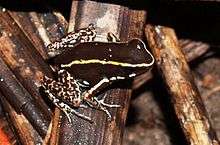Lovely poison frog
| Lovely poison frog | |
|---|---|
 | |
| Scientific classification | |
| Kingdom: | Animalia |
| Phylum: | Chordata |
| Class: | Amphibia |
| Order: | Anura |
| Family: | Dendrobatidae |
| Genus: | Phyllobates |
| Species: | P. lugubris |
| Binomial name | |
| Phyllobates lugubris (Schmidt, 1857) | |
| Synonyms[2] | |
|
Dendrobates lugubris Schmidt, 1857 | |
The lovely poison frog or lovely poison-arrow frog (Phyllobates lugubris) is a species of frog in the family Dendrobatidae. It is found on the Caribbean versant of Central America from southeastern Nicaragua through Costa Rica to northwestern Panama, with one record just west of the Panama Canal.[1][2][3] Populations from the Pacific versant, formerly included in this species,[4] are now identified as Phyllobates vittatus.[2]

Description
Adult males measure 18.5–21 mm (0.73–0.83 in) and females 21–24 mm (0.83–0.94 in) in snout–vent length. Maxillary teeth are present. The dorsum is black with a pair of dorsolateral stripes, typically pale yellow to gold or orange, running along the sides of the dorsum from near the hindlimbs to the snout. The limbs are usually mottled with yellow–greenish yellow. The ventral surfaces are mottled with extensive black pigment, often to an extent that gives nearly solid black appearance.[4][3]
Habitat and conservation
Phyllobates lugubris inhabits humid lowland forests (marginally the premontane forests) at elevations of 10–601 m (33–1,972 ft) above sea level. It can also occur in secondary growth and plantations. It is diurnal and terrestrial. Adult frogs are often found by rocky sections of forest streams. Eggs are laid in dry leaf-litter. The hatching tadpoles are transported by males to forest streams to complete the larval development.[1]
General habitat loss and pollution are potential threats to this species. Chytrid fungos Batrachochytrium dendrobatidis has been detected in museum specimens buts its impact on natural populations is unknown. Phyllobates lugubris is sometimes present in the pet trade, with some illegal collection occurring. It is listed in the CITES Appendix II. It is present in several protected areas.[1]
References
- 1 2 3 4 IUCN SSC Amphibian Specialist Group (2015). "Phyllobates lugubris". IUCN Red List of Threatened Species. IUCN. 2015: e.T55263A3026290. Retrieved 27 June 2017.
- 1 2 3 Frost, Darrel R. (2017). "Phyllobates lugubris (Schmidt, 1857)". Amphibian Species of the World: an Online Reference. Version 6.0. American Museum of Natural History. Retrieved 27 June 2017.
- 1 2 "Phyllobates lugubris Schmidt, 1857". Amphibians of Panama. Smithsonian Tropical Research Institute. Retrieved 27 June 2017.
- 1 2 Savage, Jay M. (1968). "The dendrobatid frogs of Central America". Copeia. 1968: 745–776. JSTOR 1441845.
